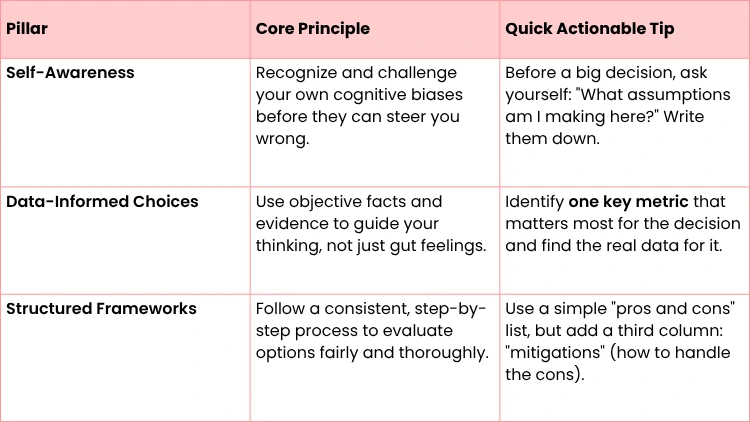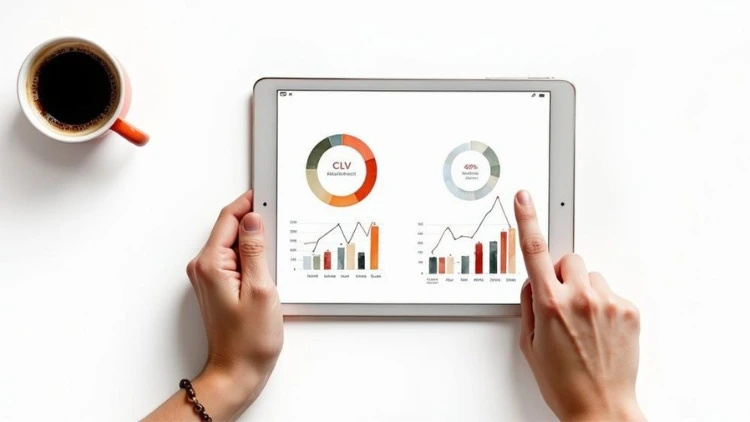How to Improve Decision Making with Smart Strategies

To really get better at making decisions, you need to focus on three core pillars: recognizing your own biases, getting comfortable with data, and following a repeatable process. This isn't about gut feelings or guesswork; it's about shifting to a systematic approach that lets you make proactive, well-reasoned choices you can stand behind.
Jump To Section

Earn As You Learn
Earn 25% commission when your network purchase Uplyrn courses or subscribe to our annual membership. It’s the best thing ever. Next to learning,
of course.
Building Your Foundation for Better Decisions
Making consistently smart choices isn’t some innate talent people are born with. It's a skill. And like any skill, it can be developed with the right foundation.
Think of it like building a house. Without a solid foundation, even the most impressive structure will eventually crumble under pressure. The goal here is to build a reliable mental toolkit you can turn to for any decision, whether it’s a small daily choice or a major strategic move.
This foundation rests on three key components:
- Spotting Hidden Biases: We all have mental shortcuts and blind spots. The first step is learning to see them for what they are.
- Using Data Effectively: It's time to move beyond pure intuition and start incorporating relevant facts and evidence into your thinking.
- Structuring Your Process: This is all about creating a simple, repeatable method to evaluate your options consistently.
The Power of a Deliberate Process
When you don’t have a process, it’s easy to fall back on old, flawed habits. Imagine a manager who needs to pick a new project management tool for their team. Without a clear process, they might just default to the software they’ve used before—a classic case of familiarity bias—even if it’s a terrible fit for their team’s actual needs.
A structured process forces you to be more objective. Instead of just going with what’s comfortable, the manager would first define what the team actually needs, compare different tools against those requirements, and maybe even use a simple scoring system to make an informed choice. This takes the emotion out of it and almost always leads to a better outcome.
Integrating Values and Data
Ultimately, the best decisions are the ones that align with both the data and your core values—whether personal or organizational. It's crucial to understand what is data-driven decision-making is all about. It doesn't mean you ignore your principles; it means you use evidence to make choices that truly reflect what's most important to you.
Practical Example: A company's data might show they could save 20% by outsourcing jobs overseas. However, if a core company value is "supporting local communities", the decision becomes more complex. The actionable insight here is to use data to find a middle ground: perhaps outsourcing only non-essential roles while investing the savings into local training programs, thus honoring the value without ignoring the financial reality.
To help you get started, we've put together a quick summary of these foundational pillars.
The Three Pillars of Better Decision Making
These three pillars work together to create a powerful, repeatable system for making better choices.
By combining self-awareness, factual analysis, and a clear method, you're not just making a single good decision. You're building a powerful system that will improve every decision you make from here on out.

Spotting and Sidestepping Mental Traps
Our brains are hardwired to take shortcuts. It’s a survival mechanism, really. These mental shortcuts, or cognitive biases, help us make snap judgments, but they can also quietly sabotage our most important choices. Getting better at making decisions often starts with learning to spot these hidden traps in the moment.
These biases aren't a sign of weakness; they're just a fundamental part of how the human mind works. The trick is to build the awareness to catch them and have a strategy ready to go.
Confirmation Bias: The Echo Chamber in Your Mind
We've all been there. Confirmation bias is our natural tendency to hunt for information that confirms what we already believe, while conveniently ignoring anything that challenges it. It’s one of the most common and damaging mental traps out there, turning our decision-making process into an echo chamber.
A classic practical example is in hiring. A manager gets a great first impression of a candidate and spends the rest of the interview unconsciously asking questions that prove their initial gut feeling was right. They'll overlook clear red flags because they're already sold.
Actionable Insight: To break out of this, you have to deliberately introduce some objectivity. A few ways to do that:
- Standardize Your Questions: Create a structured list of questions you ask every single candidate. This forces you to compare apples to apples, not just "good vibes".
- Use a Scorecard: Don’t rely on a general impression. Use a simple scoring rubric to rate candidates on specific, must-have skills and qualifications.
- Appoint a "Devil's Advocate": Ask a trusted colleague to intentionally argue against your top choice. Their job is to poke holes in your logic and force you to confront the counter-argument.
Sunk Cost Fallacy: Throwing Good Money After Bad
The sunk cost fallacy is that nagging voice telling you to stick with something—a project, an investment, a strategy—just because you've already poured time, money, or effort into it. This happens even when all signs point to failure. We let past expenses dictate future choices, which is completely irrational.
Picture a marketing team that’s spent $50,000 and three months on a new campaign that is generating crickets. Instead of pulling the plug, they decide to throw another $25,000 at it because they "can't let the initial investment go to waste". That’s the sunk cost fallacy in action.
Actionable Insight: The crucial mental shift is to evaluate the decision based only on its future potential, as if the past investment never happened. Ask yourself: "If I were starting from scratch today, knowing what I know now, would I still invest in this?"
This single question is a powerful tool for escaping the trap.
Let's be real, we all make dozens of choices every day, and it can be draining. These mental shortcuts are often a way our brain copes with the load. You can learn more about how to simplify your choices and combat this exhaustion in this article on why decision fatigue is real and how to make life simple.
By actively looking for these biases in your own thinking, you start to build the mental muscle to sidestep them, leading to clearer, more rational, and ultimately much better outcomes.

Using Data Without Getting Overwhelmed
We're all swimming in a sea of information. It's easy to feel like you're drowning in numbers, charts, and spreadsheets. But here's the secret: better decision-making isn't about collecting more data. It's about learning how to cut through the noise and pull out the insights that actually matter.
So many of us fall into the "vanity metrics" trap. We track numbers that look impressive on a dashboard but don't tell us anything useful about our strategy. It gives you the illusion of being data-driven, but it's really just busywork. The real power comes from focusing on the metrics that are directly tied to your goals.
Shifting from Collection to Insight
Let's make this real. Imagine you run an e-commerce store. You might be obsessively checking your total daily sales. That number feels important, right? But on its own, it doesn't explain why sales are up or down, or what you should do next. It’s just a raw figure.
A smarter approach is to dig a little deeper and look at metrics that tell a story:
- Customer Lifetime Value (CLV): This tells you what a customer is worth over their entire relationship with your business. It’s a game-changer for figuring out your marketing budget.
- Cart Abandonment Rate: If this number is high, you've got a flashing red light. It could be your checkout process, unexpected shipping costs, or a glitchy website. Fixing this is a direct path to more revenue.
- Conversion Rate by Traffic Source: This shows you which of your marketing channels—social media, email, organic search—are actually bringing in paying customers. Now you know where to double down.
When you shift your focus from a single number like daily sales to these kinds of insights, you can start making strategic calls on inventory, marketing spend, and your website. This is what it truly means to use data to improve your decision-making.
Making Data an Accessible Tool
The explosion of information is both a blessing and a curse. By 2025, it's expected that 80–90% of all global data will be unstructured, making AI a critical partner for sorting through it all. This isn't just a futuristic trend; it's happening now. In fact, 80% of business leaders already say better data access has improved their company’s choices. You can discover more insights on research and decision-making predictions that dig into this shift.
Actionable Insight: The goal isn't to become a data scientist overnight. It's about learning to ask better questions and using simple tools to get the answers. Just start by identifying one key question you need to solve, then find the specific data that will point you in the right direction. For instance, instead of asking "How do we increase sales?" ask "Which customer segment has the highest repeat purchase rate, and what do they buy?" The second question gives you a clear data trail to follow.
This targeted approach to gathering information is a core part of making smarter choices.
Let AI Do the Heavy Lifting
Think of artificial intelligence as an unbiased partner in your decision-making process. AI tools are brilliant at combing through massive datasets to spot patterns and connections a human could easily miss.
Practical Example: A retail manager could use an AI tool to cross-reference sales data with local weather patterns. They might discover that rainy weekends trigger a spike in online orders for board games and puzzles. The actionable insight? Armed with that knowledge, they can tweak their digital ad campaigns to capitalize on the next gloomy forecast, running targeted ads for "rainy day activities" to people in affected areas.
Suddenly, overwhelming data becomes a simple, predictive advantage. That makes AI an invaluable tool for any modern decision-maker.

Choosing the Right Framework for Tough Calls
When the stakes are high, going with your gut is a recipe for disaster. We've all been there. Tough calls demand more than just intuition; they need a structured game plan. Using a decision-making framework is like taking a step back to see the whole chessboard, letting you make a move based on logic instead of the pressure of the moment.
Think of these frameworks less as complicated theories and more as simple, powerful mental models. They cut through the noise of a complex situation and give you a clear path forward, especially when it really counts.
Go Beyond the Obvious with Second-Order Thinking
Most of us are pretty good at first-order thinking. We see a problem, and we jump on the most obvious, immediate solution. It's a natural human tendency.
But second-order thinking is where the real magic happens. It's the discipline of looking past that easy, initial answer to map out the chain reaction of consequences that will follow.
Practical Example: Let's say a company is floating the idea of a four-day workweek.
- First-Order Thinking: "Awesome! Everyone gets a three-day weekend. People will be happier and more rested, so morale and productivity will shoot up." This is the immediate, feel-good result.
- Second-Order Thinking: "Okay, hang on. What happens next? Will clients get frustrated when they can't reach us on Fridays? Will our team feel pressured to cram five days of work into four, leading to burnout instead of bliss? How do we handle urgent project handoffs?"
Actionable Insight: This deeper level of analysis doesn't mean the four-day workweek is a bad idea. It just forces you to anticipate the ripples and plan for them, turning a potentially good idea into a genuinely successful one. To practice this, take any upcoming decision and create two columns: "Immediate Effects" and "Consequences of those Effects". This simple exercise trains your brain to think one step ahead. Honing this skill is a huge part of building stronger analytical abilities. If you want to dig deeper into this, this guide on how to improve critical thinking is a great next step.
Minimize Future Regret with a Simple Framework
Another incredibly powerful tool, especially for those life-altering decisions, is the Regret Minimization Framework. Jeff Bezos famously used this mental model when he decided to leave a stable Wall Street job to start a little online bookstore called Amazon. It’s just as effective for our own big choices, personal or professional.
The process is deceptively simple. When you're at a major crossroads, fast forward in your mind and picture yourself at age 80. From that perspective, look back on your life and ask one simple question: "Which choice will I regret less?"
Practical Example: Take a software developer with a secure, well-paying corporate job. She gets an offer to join a risky but exciting startup. The immediate choice feels terrifying. But by imagining her 80-year-old self, she can completely reframe the question. Will she regret leaving her safe job, or will she regret never knowing if she could have helped build something amazing from the ground up?
Actionable Insight: This framework slices right through the short-term fear and anxiety that so often cloud our judgment. It shifts your focus to the long-term story of your life, making it easier to see which path truly aligns with your core values and aspirations. By checking in with your future self, you can make a decision today that you'll be proud of for decades.

How AI Is Shaping the Future of Decision Making
Artificial intelligence is no longer some far-off, sci-fi concept. It's quickly becoming a real, practical partner in the choices we make every day. It's not just for massive tech companies anymore; AI is now an accessible tool that can amplify your own skills, helping you make smarter, more informed decisions by crunching numbers at a scale no human ever could.
Practical Example: Think about a supply chain manager. Not too long ago, their best bet was to rely on last year's sales data and a healthy dose of intuition. Now, an AI platform can chew through that same data but also layer in real-time weather forecasts, what's trending on social media, and global economic news. Suddenly, they can predict future demand with an almost spooky level of accuracy. This is AI in action—shifting us from just reacting to what happened to predicting what will.
Augmenting Human Insight
Let's be clear: AI isn't here to take over. It's here to back you up. Its greatest strength is its ability to analyze massive datasets without the cognitive biases that so often lead us astray. This makes it an incredibly powerful ally, especially when the stakes are high and you absolutely need objectivity.
Practical Example: Take the financial services industry. AI algorithms can review loan applications by looking only at the financial data. This strips away the unconscious human biases tied to someone's background, gender, or even what kind of day the loan officer is having. The result is fairer, more consistent decisions for everyone. To really get a handle on this, it's worth exploring the role of intelligent agents in AI.
Embracing this technology is no longer optional if you want to stay competitive. In fact, by 2025, AI is set to completely overhaul decision-making by automating data analysis, generating predictive insights, and letting us make adjustments on the fly. AI systems can tackle complex jobs like fraud detection and risk assessments far more efficiently than humans, leading to choices that are both faster and more accurate.
Integrating AI Into Your Process
You don't need a Ph.D. in computer science to start using AI. The truth is, many of the business tools you already use probably have AI features baked right in. The trick is to identify the spots in your workflow where more data could lead to better outcomes.
Here are a few actionable insights to get you started:
- For Marketing: Use AI tools to see what your customers are actually doing.
Actionable Insight: Instead of guessing, use an AI-powered analytics tool to identify the exact point where users drop off in your sales funnel. This tells you precisely where to focus your improvement efforts, whether it's a confusing webpage or a broken link. - For Operations: Bring in AI-powered software to get a better handle on your inventory. You'll cut down on waste and make sure you always have what customers want, right when they want it.
- For Strategy: Tap into predictive analytics to model the potential fallout of different business strategies. It’s like getting a sneak peek at the road ahead before you commit to a direction.
The real game-changer with AI is its ability to learn and adapt on its own. As it takes in new information, its insights get sharper, ensuring your decisions are always based on the most current and relevant data out there.
This kind of human-machine teamwork isn't some futuristic dream; it's rapidly becoming the new standard for making high-quality decisions. To dig deeper into this evolving dynamic, check out what the future looks like for how teams with AI agents and humans will perform. By bringing these tools into your process, you can stay ahead of the curve and make choices that are not just smart, but truly forward-looking.
Common Questions About Improving Your Decisions
Even with the best frameworks in your back pocket, putting them into practice is where things get interesting. The real world is messy, and it’s completely normal to hit a few snags when you're trying to make better choices. Let's walk through some of the most common questions that pop up.
Think of this as the troubleshooting guide for your decision-making engine. Getting these sorted is a huge part of learning how to improve decision making for good.
How Do I Make Good Decisions Under Pressure?
When the clock is ticking and everyone's looking at you, it's so easy to fall back on snap judgments. The trick isn't to try and run a full, complex analysis in 30 seconds. Instead, you need a simplified, go-to process ready to deploy.
Practical Example: Imagine a project manager staring down an unexpected crisis right before a deadline. Instead of spiraling, they could just pause—even for 60 seconds—and ask themselves two powerful questions:
- Which option does the most to protect our client relationship right now?
- Which choice buys us the most time to figure out a proper long-term fix?
Actionable Insight: This little framework cuts through the noise. It helps you make a deliberate, tactical choice instead of a purely reactive one. When you're under the gun, the goal isn't perfection; it's calculated damage control that keeps you moving in the right direction. Create a "pressure cheat sheet" with 2-3 of these core questions for your specific role and keep it visible.
What If I Don’t Have Enough Information?
This is a big one. That feeling that you just don't have all the facts is a primary cause of decision paralysis. Here's the thing, though: waiting for 100% certainty is a surefire way to do nothing at all. Almost every important decision you'll ever make will be based on incomplete information.
The key is to reframe your objective. You’re not trying to find the one, perfect, flawless answer. You’re trying to make the best possible decision with the data you have on hand right now.
Tasha Eurich, an organizational psychologist, did some fascinating research on this. She found that while 95% of people believe they’re self-aware, the reality is that only 10-15% truly are. We all have blind spots and will never have a perfect, complete picture.
Actionable Insight: So, acknowledge what you don’t know, make a reversible choice if you can (a "two-way door" decision, as Jeff Bezos calls it), and get ready to pivot as you learn more. Frame your decision as an experiment, not a final verdict.
Should I Trust My Gut Feeling?
Your gut feeling isn't some kind of magic. It's actually your brain’s incredible ability to process your past experiences and spot patterns subconsciously. Think of it as a lightning-fast internal shortcut. It's a valuable signal, for sure, but it shouldn't be the only thing guiding your choice.
The smartest way to use your intuition is as a trigger for more digging.
Practical Example: Let's say you're considering a new business partner. On paper, they look perfect—great credentials, solid history, glowing recommendations. But something just feels...off.
Actionable Insight: Don't just dismiss that feeling. Use it. Let that gut feeling prompt you to ask tougher questions, check one more round of references, or look into their past projects with a more critical eye. Your intuition is the alarm bell, not the final verdict.
Ultimately, getting better at making decisions is a skill you practice over time. It's about blending smart analysis with a healthy dose of self-awareness and, most importantly, being willing to learn from every choice you make—both the wins and the ones that don't pan out.
At Uplyrn, we believe that strong decision-making is a skill anyone can build. Explore our courses on critical thinking and personal development to gain the confidence you need to make better choices in your career and life.


Leave your thoughts here...
All Comments
Reply